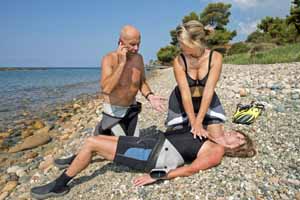Your cart is currently empty!
CPR Study: How Bystander CPR Affects Nursing Home Admission and Brain Damage After Cardiac Arrest
Bystander CPR has been linked to a 30 percent decrease in risk of nursing home admission and brain damage in survivors of cardiac arrest outside of the hospital, a new study found.

Dr. Kristan Kragholm, a student in the Department of Anesthesiology in Aalborg University, was a part of the research team who studied the degree of disability of nursing home cardiac arrest survivors. Unlike previous studies, which solely examine the survival rate, this study conducted by the European Society of Cardiology actually investigated the degree of disability among these survivors.
Researchers from the study took records from Denmark between 2001 and 2011 of out-of-hospital cardiac arrest patients. Out of the 32,883 patients, 2,469 survived cardiac arrest after 30 days and of those survivors, 2,387 patients did not have brain damage or live in a nursing home before the incident. Researchers took several factors into play, such as admission of CPR and year of arrest, and then evaluated the patient’s condition one year following the incident. After a year, researchers looked at two factors: nursing home admission and brain damage hazard ratio.
The results of the study found that the practice of bystander CPR outside of the hospital results in a 30 percent decrease in brain damage or nursing home admission among survivors of cardiac arrest. When broken down, 7 percent of patients died, 11 percent were admitted to a nursing home and 81 percent did not experience either event.
Sudden Cardiac Arrest and CPR, AED & First Aid for seniors
Sudden cardiac arrest (SCA) is the leading cause of death among adults over the age of 40 in the United States and other countries. The number of people who die from SCA every year is roughly equivalent to the number of people who die from Alzheimers disease, assault with firearms, breast cancer, cervical cancer, colorectal cancer, diabetes, HIV, house fires, motor vehicle accidents, prostate cancer and suicides combined, according to sca-aware.org.
SCA is a life-threatening condition, but can be successfully treated with early intervention of CPR, automated external defibrillator (AED) and advanced cardiac life support (ACLS) protocols.
When bystander intervention (CPR) occurs with compressions and the use of an AED prior to EMS arrival, four out of 10 victims survive.
CPR Certification for Laypersons
Receiving CPR certification and training is the first step needed to save those who have experienced SCA outside of the hospital. There are several ways an individual can become CPR certified. Many often choose to attend a weekend class locally when one is offered, or they choose to take an online CPR certification class that can be taken at anytime. Regardless of the preferred method, NHCPS hopes that our mission to empower others to spread health care knowledge, such as that of CPR, can become a goal of the general public’s as well.







Leave a Reply